By Glenn Selk, Oklahoma State University Emeritus Extension Animal Scientist
The “value-added” calf sales are well under way on the summer video sales and will certainly pick up as we enter the calf run. Therefore, some of the required weaning dates may already be here, and others are only a few days away. Most of the “Value-Added” calf sales require that the calves are weaned at least 45 days prior to sale date. Some cow calf producers may wonder why the post-weaning period needs to be so lengthy.
Data from Iowa (Faber, et al. 1999 Iowa State University Beef Research Report) from over a nine-year period in a couple of their feedout tests compared the health status of calves weaned less than 30 days to calves weaned longer than 30 days. Data from over 2000 calves were summarized. Calves that had been sent to a feedlot at a time less than 30 days had a higher incidence of bovine respiratory disease (28%) compared to calves weaned longer than 30 days (13%).
The percentage of calves that required 3 or more treatments also was significantly different (6% versus 1%) in favor of calves that had been weaned more than 30 days. In fact, the calves weaned less than 30 days were not different in health attributes than calves that were weaned on the way to the feedlot. A summary of this lengthy study can be found online here.
Vac-45 calves apparently have a real advantage in terms of health compared to calves weaned for less than a month or those weaned on the way to the livestock market for sale date. Certainly, part of the “value” in value-added calves can be attributed to properly applied vaccinations. However, there is little doubt that a portion of the improved health is due to the length of time between weaning and the movement of calves to the next owner.


